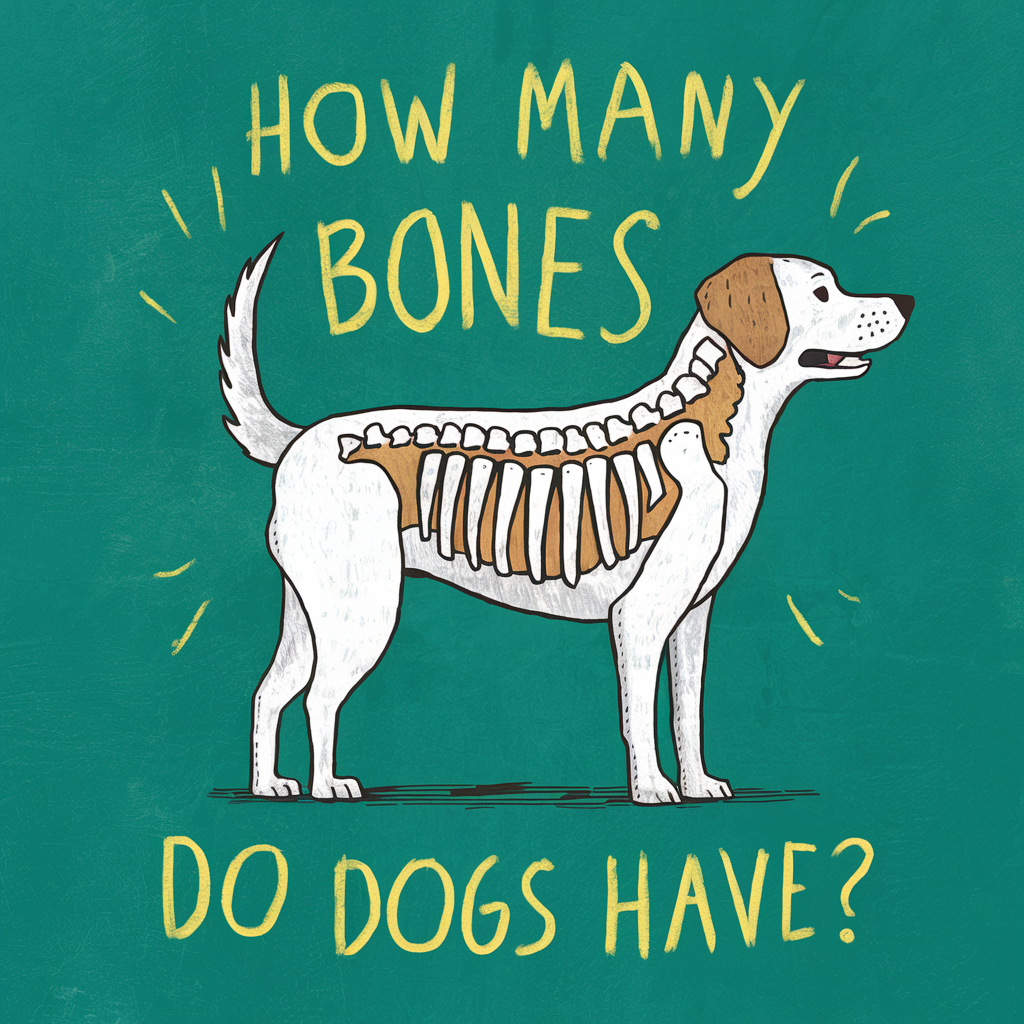Understanding the skeletal structure of dogs is not only fascinating but also essential for any pet owner. Knowing how many bones do dogs have, along with the specifics of their skeletal anatomy, can help in providing better care, ensuring their overall health, and recognizing potential issues early. This article aims to delve into the intricate details of a dog’s skeleton, exploring the number of bones they have, the variations in different parts of their body, and how these differences can affect their movement and health. We’ll also touch on related topics that contribute to a dog’s wellbeing, making this a comprehensive guide for dog lovers and owners alike.

How Many Bones Do Dogs Have?
Dogs typically have around 320 bones in their bodies, though the exact number can vary slightly depending on the breed and whether certain bones have fused together as the dog matures. This is notably more than the average human, who has 206 bones. The additional bones in dogs, especially in their tails and spinal columns, contribute to their unique flexibility and range of motion.
Understanding the canine skeletal system is crucial for comprehending their physical capabilities and potential health issues. For instance, puppies undergo significant skeletal changes as they grow, which is why it’s important to monitor their development. For detailed insights into what your puppy should be doing and learning as they grow, check out this guide on 6 to 12-month-old puppy development.
By comparing the canine skeletal system to the human skeletal system, we can appreciate the specialized adaptations that enable dogs to perform incredible feats of agility, strength, and speed. These differences are also crucial when considering the care and maintenance of your pet’s bones and joints throughout their life.

How Many Bones Do Dogs Have in Their Tail?
A dog’s tail is a remarkable structure composed of many small bones called vertebrae. The number of bones in a dog’s tail can vary significantly based on the breed and length of the tail, typically ranging from 5 to 23 vertebrae. These bones are connected by flexible joints, allowing the tail to move in various directions, which is crucial for balance, communication, and expression.
For instance, breeds with long, bushy tails like the Golden Retriever will have more tail bones compared to breeds with short or docked tails, such as the Bulldog. The flexibility and number of bones in the tail allow dogs to use it as a rudder while swimming, a balancing tool when making sharp turns, and a means of expressing emotions.
Proper care of a dog’s tail is essential, especially for breeds with longer tails that are more prone to injury. Providing a safe and comfortable environment for your dog, such as creating a dedicated space using DIY wood indoor dog kennel plans, can help prevent tail injuries and other skeletal issues.

How Many Bones Do Dogs Have in Their Skull?
The canine skull is a complex structure designed to protect the brain, support the sensory organs, and facilitate feeding. Dogs typically have around 50 bones in their skull, although this number can vary slightly depending on the breed and specific anatomical features. The skull is divided into two main parts: the cranium, which houses and protects the brain, and the facial bones, which include the jaw, nose, and eye sockets.
Different breeds exhibit significant variations in skull shape and structure. For instance, brachycephalic breeds like Bulldogs and Pugs have shorter, broader skulls, while dolichocephalic breeds like Greyhounds have longer, narrower skulls. These structural differences can influence not only the number of bones but also the overall shape and functionality of the skull.
Understanding these differences is crucial when choosing a breed that fits your lifestyle and ensuring their health. For example, the Cockapoo, a delightful crossbreed, combines traits from both parent breeds, potentially leading to a unique skull structure that impacts their health and care needs. Similarly, Cavapoo puppies are another example of a breed with distinct skull features that influence their behavior and care requirements.
These variations highlight the importance of breed-specific knowledge when it comes to understanding and maintaining your dog’s skeletal health, ensuring that they receive the best possible care tailored to their unique anatomical needs.

What Are the Major Differences Between Dog and Human Skeletons?
While dogs and humans share some basic skeletal similarities, there are significant differences that highlight each species’ unique adaptations and capabilities. Understanding these differences can help pet owners better appreciate their dog’s physical abilities and health needs.
1. Number of Bones
- Dogs have approximately 320 bones, compared to the 206 bones in the human skeleton. This difference is mainly due to the greater number of vertebrae in a dog’s spine and tail.
2. Skull Structure
- The canine skull is more elongated and varied among breeds, adapted to different feeding habits and sensory needs. Human skulls, in contrast, are more uniform in shape and designed primarily for protecting the brain and facilitating speech.
3. Spine and Tail
- A significant difference is the canine tail, which contains 5 to 23 vertebrae, depending on the breed. This tail structure aids in balance and communication. Humans, lacking tails, have a more rigid and shorter spine.
4. Limb Structure
- Dogs are digitigrade animals, meaning they walk on their toes. This adaptation gives them greater speed and agility. Humans are plantigrade, walking on the soles of their feet, which supports bipedal movement.
5. Rib Cage
- Dogs typically have 13 pairs of ribs, while humans have 12. This extra pair of ribs provides additional support and protection for the organs in the chest cavity.
6. Joint Flexibility
- Canine joints are generally more flexible, particularly in the legs and spine, allowing for greater range of motion and agility. This flexibility is crucial for their hunting and running capabilities.
Understanding these structural differences helps in recognizing why dogs are so adept at activities like running, jumping, and swimming. Speaking of swimming, it’s important to consider the safety of your dog when they swim in pools with chlorine. For more details on how to ensure your dog’s safety in such environments, check out this guide on dogs swimming in pools with chlorine.
These anatomical differences also underscore the importance of breed-specific care, ensuring that each dog receives the appropriate exercise, diet, and medical attention tailored to their unique skeletal structure and physical needs.

How Does Breed Affect the Number of Bones in a Dog’s Skeleton?
The number of bones in a dog’s skeleton can vary slightly depending on the breed, primarily due to differences in tail length and skull structure. These variations are a result of selective breeding for specific traits, such as size, shape, and functionality. Understanding these breed-specific differences can help in providing tailored care and recognizing potential skeletal issues.
1. Tail Bones
- Long-Tailed Breeds: Breeds like the Golden Retriever and German Shepherd typically have more vertebrae in their tails, providing greater flexibility and aiding in balance and communication.
- Short-Tailed Breeds: Breeds such as Bulldogs and Boxers often have shorter tails with fewer vertebrae. In some breeds, tails are docked, further reducing the number of tail bones.
2. Skull Bones
- Brachycephalic Breeds: Dogs like Pugs and Bulldogs have shorter, broader skulls with fewer, more compact bones. This can lead to respiratory issues and requires special care.
- Dolichocephalic Breeds: Breeds such as Greyhounds and Collies have longer, narrower skulls with more elongated bones. These breeds often have better vision and a higher sense of smell due to their skull structure.
3. Body Size and Shape
- Giant Breeds: Dogs like Great Danes and Saint Bernards have larger, more robust bones to support their massive frames. This includes larger vertebrae, ribs, and limb bones.
- Toy Breeds: Smaller breeds like Chihuahuas and Pomeranians have more delicate, smaller bones. Their compact skeletal structure makes them more prone to injuries and requires careful handling.
4. Limb Length
- Long-Legged Breeds: Breeds such as Whippets and Afghan Hounds have longer limb bones, contributing to their speed and agility.
- Short-Legged Breeds: Breeds like Dachshunds and Basset Hounds have shorter limb bones, which can lead to specific health issues such as intervertebral disc disease.
Breed-specific skeletal structures not only affect the number of bones but also influence a dog’s overall health and care requirements. For example, providing adequate summer care tailored to your dog’s breed can prevent heat-related issues. Learn more about how to keep your pup cool and safe with these top summer safety tips for dogs.
Understanding these differences allows pet owners to better address the unique needs of their dogs, from choosing the right diet and exercise regimen to recognizing breed-specific health concerns. This knowledge helps ensure that dogs of all breeds live healthy, active, and fulfilling lives.
Common Skeletal Disorders in Dogs
Dogs, like humans, can suffer from various skeletal disorders that can affect their mobility, comfort, and overall health. Recognizing the signs of these conditions early and seeking appropriate veterinary care can make a significant difference in managing and treating these issues. Here are some of the most common skeletal disorders found in dogs:
1. Hip Dysplasia
- Description: Hip dysplasia is a genetic disorder where the hip joint doesn’t fit properly into the hip socket. This can lead to pain, arthritis, and mobility issues.
- Breeds at Risk: Large breeds such as German Shepherds, Labrador Retrievers, and Great Danes are particularly susceptible.
- Management: Weight management, physical therapy, and in severe cases, surgery, can help manage this condition.
2. Elbow Dysplasia
- Description: This condition involves the abnormal development of the elbow joint, leading to arthritis and lameness.
- Breeds at Risk: Common in large breeds like Golden Retrievers, Rottweilers, and Bernese Mountain Dogs.
- Management: Similar to hip dysplasia, treatments include weight control, anti-inflammatory medications, and surgery if necessary.
3. Intervertebral Disc Disease (IVDD)
- Description: IVDD occurs when the discs between the vertebrae herniate or burst, pressing on the spinal cord and nerves. This can cause pain, nerve damage, and paralysis.
- Breeds at Risk: Dachshunds, Pekingese, and Corgis are particularly prone due to their long bodies.
- Management: Treatment can range from rest and medication to surgical intervention, depending on the severity.
4. Osteoarthritis
- Description: A degenerative joint disease where the cartilage in the joints breaks down, causing pain and stiffness.
- Breeds at Risk: Older dogs and breeds predisposed to joint issues.
- Management: Weight management, pain relief medications, joint supplements, and physical therapy can help manage symptoms.
5. Patellar Luxation
- Description: This occurs when the kneecap (patella) dislocates from its normal position. It can cause lameness and discomfort.
- Breeds at Risk: Small breeds like Pomeranians, Chihuahuas, and Yorkshire Terriers.
- Management: Mild cases may be managed with physical therapy, while severe cases might require surgery.
6. Cruciate Ligament Injuries
- Description: The cruciate ligament in the knee can tear, leading to instability and pain. This is similar to ACL injuries in humans.
- Breeds at Risk: Active breeds and those that are overweight.
- Management: Surgery is often required, followed by physical rehabilitation.
Preventative Measures and Treatments
- Regular Check-ups: Routine veterinary visits can help detect skeletal issues early. Early intervention is key to managing many of these conditions effectively.
- Proper Nutrition: Ensuring your dog has a balanced diet rich in nutrients that support bone health is crucial. This can be complemented by providing natural dog treats for healthy snacking.
- Weight Management: Maintaining a healthy weight reduces the strain on your dog’s joints and bones, helping prevent disorders like hip and elbow dysplasia.
- Physical Activity: Regular, moderate exercise helps keep your dog’s joints flexible and muscles strong. However, avoid over-exertion, especially in breeds prone to skeletal issues.
- Parasite Prevention: Keeping your dog free from parasites like fleas and ticks is crucial, as these pests can exacerbate joint and bone problems. For effective strategies, check out this guide on winning the battle against fleas and ticks.
Understanding and recognizing these common skeletal disorders can help you provide the best care for your dog, ensuring they lead a comfortable and active life. Regular veterinary care, a balanced diet, and appropriate exercise are key components in maintaining your dog’s skeletal health.

How to Support Your Dog’s Bone Health
Supporting your dog’s bone health is crucial for ensuring they lead a long, active, and pain-free life. Proper nutrition, regular exercise, and preventative care are essential components in maintaining strong bones and joints. Here are some key strategies to help support your dog’s skeletal health:
1. Balanced Diet
- Nutrient-Rich Food: Ensure your dog’s diet is rich in essential nutrients such as calcium, phosphorus, and vitamin D, which are vital for bone development and maintenance. High-quality commercial dog foods are typically formulated to meet these needs.
- Supplements: If your dog has specific dietary requirements or is prone to bone issues, consider supplements that support bone health. Always consult with your veterinarian before adding any supplements to your dog’s diet.
- Natural Treats: Incorporate healthy, natural dog treats into their diet to boost their overall nutrition. For ideas, check out these natural dog treats for healthy snacking.
2. Regular Exercise
- Consistent Activity: Regular, moderate exercise helps maintain joint flexibility, muscle strength, and overall bone health. Activities like walking, running, and swimming are excellent for dogs.
- Avoid Over-Exertion: Especially in growing puppies and breeds prone to skeletal issues, it’s important not to over-exert them. Tailor exercise routines to your dog’s age, breed, and health status.
3. Weight Management
- Healthy Weight: Keeping your dog at a healthy weight reduces stress on their bones and joints, preventing issues like arthritis and dysplasia.
- Portion Control: Monitor your dog’s food intake and avoid overfeeding. Use feeding guides and consult with your vet to determine the appropriate portion sizes for your dog.
4. Preventative Care
- Regular Check-ups: Routine veterinary visits help catch potential bone issues early. Your vet can provide tailored advice based on your dog’s specific health needs.
- Vaccinations and Parasite Control: Keeping your dog free from parasites like fleas and ticks is crucial, as these can exacerbate joint and bone problems. Learn effective strategies in this guide on winning the battle against fleas and ticks.
5. Safe Environment
- Comfortable Living Spaces: Provide a safe and comfortable living environment for your dog. Consider creating a cozy space with these DIY wood indoor dog kennel plans.
- Injury Prevention: Ensure your home and yard are free from hazards that could cause falls or injuries. Avoid slippery surfaces and provide ramps or steps if necessary.
6. Tailored Activities
- Age-Appropriate Exercises: Engage your dog in activities suitable for their age and breed. For instance, swimming is a low-impact exercise that is excellent for joint health. Ensure pool safety by referring to this guide on dogs swimming in pools with chlorine.
By incorporating these strategies into your dog’s routine, you can significantly support their bone health, ensuring they remain active and happy throughout their life. Regular care and attention to their dietary and exercise needs, coupled with preventative measures, will help keep your dog’s skeletal system strong and healthy.

As an Amazon Associate we earn from qualifying purchases through some links in our articles.




